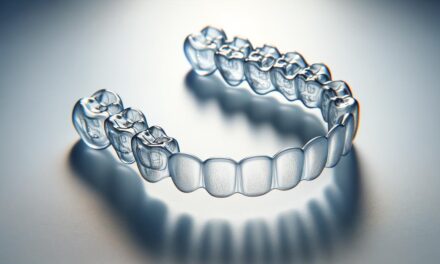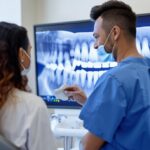Dental Glossary: Exploring Essential Terms in Dentistry
A
Abfraction: A type of dental wear that occurs at the neck of the tooth near the gum line, caused by stress and flexion from bruxism or abnormal bite forces.
Abscess: A localized infection with pus in the soft gum tissues or at the root of a tooth, often painful and requiring prompt treatment.
Amalgam: A durable material used for dental fillings, consisting of a mixture of mercury, silver, tin, and copper.
Anodontia: A rare genetic condition where some or all of the permanent teeth are missing at birth.
Alveolar Bone: The part of the jawbone that holds the tooth sockets, playing a critical role in the support and stability of teeth.
Apicoectomy: A surgical procedure where the tip of the tooth root is removed to treat a persistent infection in the surrounding bone.
B
Bite Alignment (Occlusion): Refers to how upper and lower teeth align when the mouth is closed, critical for proper function and oral health.
Bruxism: The involuntary or habitual grinding and clenching of teeth, often during sleep, potentially causing tooth damage and jaw disorders.
Biopsy: A diagnostic procedure that involves the removal of tissue from the oral cavity to identify diseases like cancer.
Bonding: A cosmetic dental technique that applies a tooth-colored composite resin to repair and improve the appearance of damaged teeth.
Bridge: A dental restoration used to replace one or more missing teeth by anchoring an artificial tooth to adjacent natural teeth or implants.
C
Canine Teeth: Also known as cuspids, these teeth are pointed and are used for tearing food. They play a vital role in maintaining the arch and bite.
Cavity: A decayed part of a tooth caused by bacterial activity, which if untreated, can lead to further decay, pain, and infection.
Cephalometric X-ray: A specialized X-ray used in orthodontics to provide a complete radiographic image of the side of the face, aiding in the assessment of teeth, jaw relationships, and growth patterns.
Crown: A dental restoration that completely caps or encircles a tooth or dental implant, often used to restore its shape and functionality.
Composite: A tooth-colored filling material used in dental restorations, made from a mixture of synthetic resins and fine glass particles.
Crossbite: A form of malocclusion where some upper teeth close inside the lower teeth instead of outside, potentially causing jaw strain and uneven wear.
Calculus (Tartar): Hardened dental plaque on teeth or dental implants that is difficult to remove and can contribute to gum disease.
Crown Lengthening: A surgical procedure to expose more of the tooth by reshaping gum tissue and bone, usually to allow for a proper fitting crown or bridge.
D
Deciduous Teeth: Commonly known as baby teeth or milk teeth, these are the first set of teeth in human development, which eventually fall out to make way for permanent teeth.
Dentin: The sensitive tissue beneath the tooth enamel and cementum, making up the bulk of tooth structure and surrounding the pulp.
Dental Implant: A titanium post placed surgically into the jawbone to replace the root part of a missing tooth, supporting a crown, bridge, or denture.
Denture: A removable replacement for missing teeth and surrounding tissues, available as complete or partial sets.
Diastema: A gap or space between two teeth, commonly seen between the upper front teeth and often considered a cosmetic concern.
Digital Impressions: A modern technique where optical scanning devices are used to create a digital map of the teeth, replacing traditional methods of taking impressions with physical materials.
E
Enamel: The hard, outer surface of teeth, providing protection from decay; it is the hardest and most mineralized substance in the body.
Endodontist: A dental specialist focused on treating diseases and injuries of the tooth pulp and periapical tissues of the teeth.
Extraction: The process of removing a tooth, typically due to disease, trauma, or overcrowding in the mouth.
Enameloplasty: Cosmetic dental procedure involving the minor reshaping of natural teeth to improve their appearance and alignment.
Endodontics: The branch of dentistry concerning dental pulp and tissues surrounding the roots of a tooth, primarily involving root canal treatment.
Eruption: The process by which teeth move through the gum tissue and emerge into the mouth.
F
Filling: A way to restore a tooth damaged by decay back to its normal function and shape, using materials like gold, porcelain, or composite resin.
Fluoride: A mineral added to dental products and some water supplies to strengthen teeth and reduce the risk of decay.
Frenectomy: A surgical procedure to remove or adjust the frenulum, a connective tissue found in several parts of the mouth, to resolve issues that affect oral function.
Fissure Sealant: A protective dental treatment where a plastic material is placed in the pits and fissures of children’s teeth to prevent decay.
Fluorosis: A cosmetic condition resulting from excessive fluoride intake, marked by streaks or specks on the teeth.
Full Mouth Reconstruction: A comprehensive treatment process to rebuild or restore all of the teeth in both the upper and lower jaws simultaneously.
G
Gingivitis: The initial stage of gum disease, characterized by swollen, red gums that may bleed easily, often reversible with good oral hygiene.
Gingival Contouring: A cosmetic procedure that reshapes the gum line to improve the aesthetics of a smile, often performed using lasers.
Gum Disease (Periodontal Disease): Infections and inflammation of the gums and bone that surround and support the teeth, potentially leading to tooth loss if untreated.
Gingivectomy: A periodontal surgery that removes diseased gum tissue to eliminate pockets between the teeth and gums.
Gum Graft: A type of dental surgery performed to correct the effects of gum recession and to protect exposed tooth roots from decay.
H
Halitosis: Chronic bad breath, often due to factors such as poor oral hygiene, dry mouth, or diet, requiring dental intervention for diagnosis and treatment.
Hyperdontia: A condition characterized by having an excess number of teeth. The extra teeth, called supernumerary teeth, can appear in any area of the dental arch.
Hypersensitivity: Increased sensitivity of the teeth to stimuli such as temperature changes or sweet and sour foods, often due to exposed dentin.
I
Invisalign: A brand of clear, removable dental aligners used as an alternative to traditional metal dental braces.
Incisor: Front teeth primarily used for cutting and biting into food, generally the first adult teeth to erupt.
Interdental Brush: A small brush specially designed to clean between your teeth, where a regular toothbrush does not reach.
Impaction: A condition where a tooth is blocked from erupting fully into the mouth, commonly seen with wisdom teeth.
Implant-Supported Bridge: A type of dental bridge that is supported by implants rather than natural teeth. It is used when there are several missing teeth, or when surrounding teeth are not strong enough to support a traditional bridge.
Inlay: A custom-made restoration, usually of gold or porcelain, fitted to a cavity in a tooth and cemented into place.
J
Jawbone: The hard bone forming the skeleton of the mouth and face, housing the sockets of the teeth and providing support.
Jaw Clenching: The forceful closing of the jaw muscles holding the teeth together, often unconsciously and during sleep, potentially leading to jaw pain and tooth wear.
Jawbone Resorption: The gradual loss of bone in the jaw, often occurring with age or following tooth extraction, affecting facial structure and stability of dental prostheses.
Juxtaoral Organ of Chievitz: A small, anatomical structure within the soft tissue of the cheek, theorized to be involved in the sensory nerve pathway.
K
Keratosis: The formation of thickened, white patches in the mouth, often benign and resulting from chronic irritation.
KӧR Whitening: A proprietary teeth whitening system that claims to provide significant color improvement through a unique peroxide gel formula.
L
Lingual Braces: Braces fixed to the backside of teeth, invisible from the front and used for orthodontic treatment without the aesthetic impact of traditional braces.
Local Anesthesia: Anesthetic drug applied to a specific area of the mouth to temporarily numb sensation during dental procedures, enhancing patient comfort.
Luting Agent: A type of dental adhesive used to permanently attach indirect restorations such as crowns, bridges, inlays, and onlays to teeth.
Luxation: Displacement or misalignment of a tooth, often caused by trauma.
M
Malocclusion: Any deviation from the normal positioning of the upper teeth against the lower teeth, potentially leading to a variety of oral health issues.
Mandible: The lower jawbone, a vital component of the jaw that forms the lower dental arch and articulates with the skull.
Maxillofacial Prosthesis: An artificial device used to reconstruct facial features and oral functions lost due to disease, trauma, or congenital defects.
Mucogingival Junction: The line of demarcation between the mobile mucosa lining the inside of the lips and cheeks and the fixed, gum-colored mucosa around the teeth.
N
Nitrous Oxide: A gas used for its calming and pain-reducing effects during dental procedures, commonly referred to as laughing gas.
Necrosis: The death of cells or tissues in the body, often seen in dental pulp following trauma or severe decay.
Night Guard: A protective oral appliance worn during sleep to prevent damage from teeth grinding or clenching.
O
Occlusal Guard: A dental device worn over the teeth to protect them from damage due to grinding or clenching, especially during sleep.
Occlusal Adjustment: The process of modifying the biting surfaces of teeth to correct misalignment and achieve a more favorable contact between upper and lower teeth.
Occlusal Splint: An appliance designed to minimize the effects of bruxism (teeth grinding) and TMJ disorders, typically worn at night.
Overbite: A vertical overlap of the front teeth, which can lead to a variety of functional and aesthetic dental issues if excessive.
Oral Surgeon: A dental specialist trained to perform surgical procedures within the facial complex and jaw, including extractions, implant placements, and corrective surgeries.
Osteonecrosis: The death of bone tissue due to a lack of blood supply, which can affect the jawbone in some patients, particularly those on long-term steroid therapy or bisphosphonate therapy.
P
Plaque: A soft, sticky film containing millions of bacteria that accumulate on the surface of teeth, leading to decay and gum disease if not removed regularly.
Periodontist: A dentist specializing in the treatment of gum diseases and the care of supporting structures of the teeth.
Prosthodontist: A dental specialist focusing on the design, manufacture, and fitting of artificial replacements for teeth and other parts of the mouth.
Periodontal Pocket: A deeper space created between the gum and tooth root due to gum disease, which can harbor harmful bacteria.
Periapical X-ray: A focused image that captures the entire tooth, from the crown to beyond the root where it anchors into the jaw.
Pontic: The artificial tooth in a dental bridge or denture that replaces a missing natural tooth.
Q
Quercetin: A flavonoid found in many fruits and vegetables, known for its anti-inflammatory and antioxidant properties that may help in managing gum inflammation and other oral health issues.
R
Retainer: An orthodontic appliance used post-braces to maintain the position of straightened teeth, preventing them from shifting back.
Resorption: The process by which the body breaks down and absorbs the structure of a tooth or bone, often related to disease, trauma, or aging.
Restorative Dentistry: A branch of dentistry focused on repairing and restoring teeth, gums, and tissue to optimal health and functionality, often using procedures like fillings, crowns, bridges, and implants.
Root Canal: A treatment procedure designed to remove infected or inflamed tissue from the root canal of a tooth, alleviating pain and saving the tooth.
Root Planing: A deep cleaning technique used to smooth the tooth root, remove plaque and tartar, and help gums reattach to the tooth to prevent further disease.
Rubber Dam: A small, rectangular sheet, usually made of latex, used to isolate the operative area from the rest of the mouth during dental treatments to improve sterility and access.
S
Saliva: A watery substance produced by the salivary glands in the mouth, essential for digestion, oral hygiene, and overall oral health.
Scaling: A common non-surgical treatment that involves the removal of dental plaque and calculus (tartar) from the tooth surface above and below the gum line.
Sealant: A protective coating applied to the biting surfaces of teeth to prevent cavities by sealing out plaque and food.
T
Temporomandibular Joint (TMJ): The joint on each side of the head that connects the jawbone to the skull, facilitating movements required for chewing and speaking.
Tooth Decay: The process by which tooth enamel is broken down by acids produced by bacteria in plaque, often leading to cavities.
Tooth Sensitivity: Discomfort or pain in teeth when encountering certain substances and temperatures, usually due to exposed dentin.
Tartar: Also known as calculus, a hardened form of plaque that forms on the teeth and can lead to periodontal disease if not removed during professional dental cleanings.
U
Underbite: A condition where the lower teeth project further forward than the upper teeth, often leading to bite problems and a distinctive chin appearance.
Ultrasonic Cleaning: A cleaning procedure that uses ultrasonic waves to break up plaque, tartar, and stains on the teeth.
Uvuloplasty: A surgical procedure that involves the removal or reshaping of the uvula, often performed to address sleep apnea or snoring issues.
V
Veneer: A thin layer of porcelain or composite material placed over the front of a tooth to improve its appearance by adjusting the color, shape, size, or length.
Vestibuloplasty: A surgical procedure to deepen the oral vestibule, facilitating denture fit or stabilizing loose dentures.
Vertical Bite: The height of closure between the upper and lower teeth. It is significant in dentures and restorations to ensure proper function and aesthetics.
W
Whitening: Cosmetic dental procedures or products designed to lighten teeth and remove stains, enhancing the aesthetic appearance.
Wisdom Teeth: The last set of molars to erupt in the mouth, often removed due to misalignment or impaction.
X
Xerostomia: Commonly known as dry mouth, this condition results from reduced saliva production, leading to discomfort and increased risk of tooth decay and gum disease.
X-ray: A diagnostic tool that provides vital information about the condition of teeth, bones, and tissues in the mouth.
Xylitol: A sugar alcohol used as a sweetener in chewing gums and other dental products, known to reduce the risk of decay by decreasing plaque formation.
Y
Yeast Infection (Oral Thrush): An infection of the mouth caused by the fungus Candida, characterized by white patches, redness, and soreness, potentially affecting anyone but more common in infants, elderly, and those with weakened immune systems.
Yellow Teeth: Teeth that have lost their natural whiteness due to various factors such as diet, smoking, aging, or poor oral hygiene.
Z
Zirconia Crown: A dental crown made from zirconium dioxide, a highly durable and aesthetically pleasing material that mimics the appearance of natural teeth.
Zoom Whitening: An in-office teeth whitening procedure known for its use of a special light that accelerates the bleaching process, providing immediate visible results.










